Write: Mónica Uriel, Journalist
Modena and its surroundings, the so-called Italian Food Valley. It contains excellent gastronomic treasures starting with its precious vinegar, balsamic vinegar, and Parmigiano Reggiano cheese. Its slow craftsmanship contrasts with the speed of the Ferraris, which have their cradle here.
A rich and beautiful city
A tour of the city, which has the most famous Romanesque cathedral in the world, a UNESCO World Heritage Site. By the producers of this fertile area, also a land of ancient Lambrusco vineyards and good sausages. It also allows for two years to visit the house of Luciano Pavarotti, another of the excellent names born here. As well as eating at the Osteria Francescana, three Michelin stars, whose chef, Massimo Bottura, can be seen shopping at the Albinelli market.
Modena
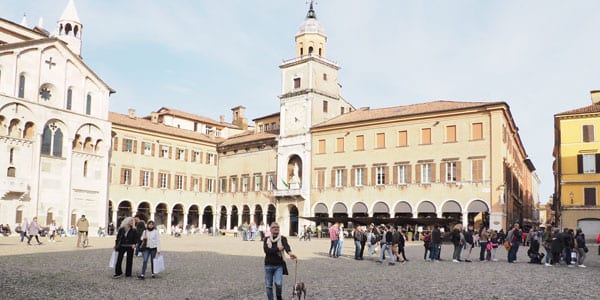
A very special product, Aceto Balsamico
We are in the Pianura Padana. A vast area of north-central Italy, where the Via Emilia, between Rimini and Piacenza, will always accompany us. In which the Romans built towns every 15 kilometers, a distance that took a day to travel. And speaking of ancient times, balsamic vinegar is the best inheritance that one generation can leave to another in Modena. What is called a battery, made up of at least five barrels for the production of this unique vinegar.
It is what is traditionally still given to children when they reach the age of majority. -because it takes 18 years to age-; it was the dowry for young brides of aristocratic families and was mentioned in wills. This is so in the case of the traditional balsamic vinegar, which eight out of ten families, about 5.000 in total, in Modena produce in their attics. With great care and affection. "I get very excited because here, in the vinegar shop, you are never alone, because you are before the work of your ancestors." Account Maurizio Fini, Grand Master and president of the Consorteria dell'aceto balsamico tradizionale a Grandesproductos. In the Museum of Spilamberto
(www.museodelbalsamicotradizionale.org).
Aceto, a tradition of Modena
Fini has no doubts that "it is the food product that needs the longest." In addition to the traditional balsamic vinegar with at least 12 years of aging. The extra old is made, with at least 25 years. Age at which people traditionally married and therefore dowry was offered.
Once the alcoholic must has been obtained, the drums are filled in their 4/5 parts. Every year in March, “when the perfume comes down the stairs”. From the successive barrel is added what has decreased from each one, and to the last one is added from the mother barrel.
Thus, of the five barrels of descending size (from 100 to 10 liters), two are for fermentation, two for maturation and the smallest, for aging. At twelve years of age, no more than a liter of aceto comes out. In 2000 came the distinction between this, the traditional, and the IGP, with much less time to prepare.
The IGP - it only requires a minimum aging of two months - and less strict regulations.
Currently 95 million liters of balsamic vinegar leave Modena every year, of which 9.000 liters are traditional. 90% of the production goes to export (it is the second most exported Italian product. After Grana Padano cheese).
Giuseppe Giusti vinegar
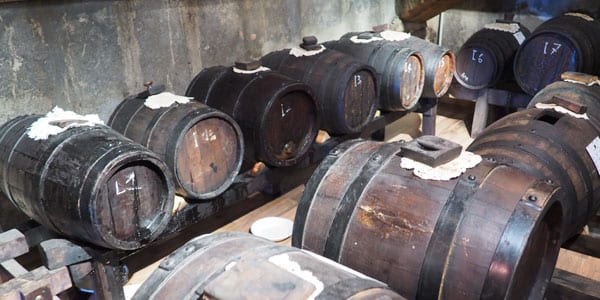
Two different products, PDO and PGI Aceto Balsamic
To differentiate it from the IGP, a 100-milliliter bottle was created. Only the traditional one can be packaged in it and it is around 100 euros. In this museum in Spilamberto, balsamic vinegar is also made for people who have their batteries in custody here, such as the chef Bottura.
Most producers make both vinegars, such as the Giusti vinegar, from 1605. The oldest in Modena, which exhibits ancient objects related to the product as well as samples of 100-year-old aceto in a museum. The vinegarwww.giusti.it) has been conducting guided tours for 15 years. It is one of the 50 vinaigrettes that can be visited in the province of Modena.
This vinegar was a time used for preservation and maceration of food. While today it is used in any dish. Although where in Modena they say that it is best expressed is on a piece of Parmigiano Reggiano and on strawberries. Balsamic vinegar is one of the 23 PDO and PGI products of the province of Modena, the European region that has the most.
Cheese factory of Parmigiano Reggiano 4 Madonne
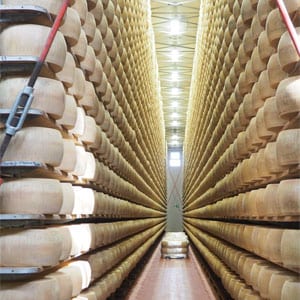
Parmigiano Reggiano, the local cheese
Another of the oldest and most famous products is Parmigiano Reggiano cheese. A PDO cheese that, in addition to being made in Modena, covers the provinces of: Parma, Reggio Emilia, Bologna and Mantua in an area of 10.000 square kilometers.
Today it is made the same as nine centuries ago and with the same ingredients: raw milk, rennet and salt, totally natural, without additives. In a process of artisan production. Of the 330 cheese factories, mostly family-owned, a total of 3.650.563 pieces left last year - with a total of 147.125 tons, 51.900 of them exported. They were made with milk from 3.000 small cow farms.
For each piece of cheese, weighing 40 kilos, 550 liters of milk are needed. In one of the largest cheese shops in the area, 4 Madonne (www.caseificio4madonne.it), just 5 kilometers from Modena. There you can see the entire production as well as a large warehouse with 30.000 pieces of cheese that are turned every 10 days. There are 18, 24 and 36 month aged cheeses and now some cheese factories are beginning long aged 72 and 80 months.
Like Modena balsamic vinegar, Parmigiano Reggiano is one of the most imitated products in the world.
Both Parmigiano Reggiano and Modena balsamic vinegar are present in the dishes prepared by Massimo Bottura. At his award-winning Osteria Francescana. In the heart of the city, and very close to the Albinelli market. A wrought iron construction, where you can see him shopping.
The gastronomy of Modena
Here you can find fresh pasta, and among it the king of the area, the tortellino, which is taken in meat broth. The tortelloni, larger and traditionally filled with ricotta, spinach and Parmigiano, or with pumpkin and Amaretto.
Modenese bread is also very present in the market, crucible, round and to which sausages are put, and the fried dumpling made from pork fat. Tourists will find discounts from April 2 to taste typical products in bars and restaurants in the city through the Coupon del Gusto. This Coupon launched by Piacere Modena (www.piaceremodena.it) gathers and promotes all the denominations of origin of the province. While to visit Modena its city council offers all the information in www.visitmodena.it.
Formerly the market was in the big square, in front of the Duomo. One of the masterpieces of European Romanesque, built from 1099. The Ghirlandina Tower, 87 meters high, served to announce the opening of the city gates. The great Ducal Palace, from 1634, today houses one of the most important military academies in Italy.
Ferrari Museum of Maranello
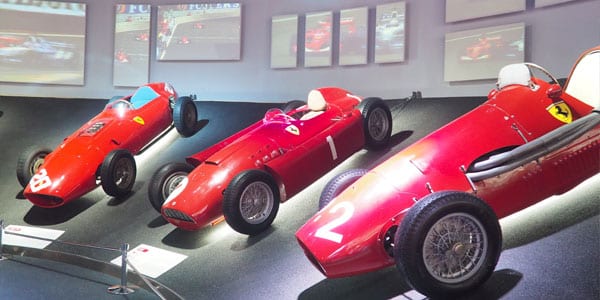
Near this palace is the house where Enzo Ferrari was born. Who at age 20 convinced his mother to sell it and thus buy his first racing car. Since 2012 it houses a museum (https://musei.ferrari.com/en/modena), with a part in the shape of a car boot. Focused on the history of Ferrari, which launched the first car in 1947, and which contains images such as the "museum of errors". In which its founder kept everything that had not worked.
When Enzo Ferrari realized that he was not a good driver, he went to Turin, to Alfa Romeo, to run a scuderia, and thus the Ferrari was born.
In Maranello, 20 kilometers away, where Enzo Ferrari ran the production, racing enthusiasts can delight in the many race cars on display. As well as the latest model, a 963 hp hybrid from 2016. The entrance to the factory is the same as in 1947, when Ferrari crossed it with its first vehicle, and from which 20 already reserved every day leave. Next to the track where the cars test is the Ristorante Montana, Michael Schumacher's favorite. Who is still the most successful driver in Formula 1.
The visit to the house-museum of Luciano Pavarotti
Regarding the winners, the tenor Luciano Pavarotti was born and lived in Modena. For two years, 10 kilometers from the city, you can visit his last home. The one he built and decorated as a haven for his retirement and which he could only enjoy for a couple of years.
In it, it seems that the singer is still there, in his bedroom with a fireplace and beautiful views. In the splendid kitchen, he senses himself painting pictures or at the piano, where he spent most of his time. It is exhibited together with the suit and scarf that he used in concerts. Numerous personal objects can be seen, in addition to his awards.
Ferrari, the star visit of the area
The tour operator Modenatur organizes visits to the Ferrari museums, including car tests, to other places in the “Motor valley”. Also visits to the gastronomic producers of the province, while a good place to sleep is the Hotel Castello (www.hotelcastello-mo.it). An ancient noble villa with a family atmosphere and located on the outskirts of Modena.
Luciano Pavarotti's house
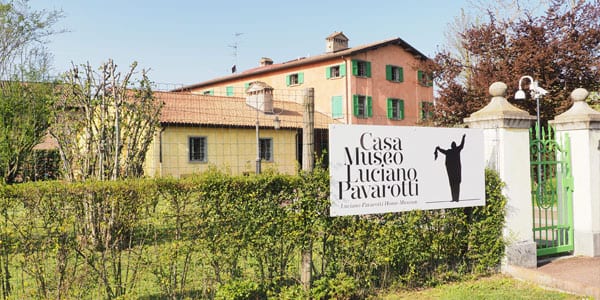
Red like the Ferrari is also another of Modena's gastronomic symbols, the Lambrusco. Like the Gasparossa di Castelvetro with its elegant bubbles, one of the four denominations of origin of the province together with: Sorbara, Salamino di Santa Croce and Modena, which mixes the three varieties. In October the leaves of the Gasparossa vineyards stain the landscape red.
Both Lambrusco and the other wine produced in these lands, Pignoletto, an alternative to prosecco. They come from ancient native vineyards that for 2.000 years have been cultivated in the fields around Modena. We find the Lambrusco in the plains and the Pignoletto, in the hills, obtained from the Grechetto Gentile grape, both sparkling wines. With little alcohol and a fresh and fruity aroma.
The lambrusco boom in the United States
Cleto Chiarli (chiarli.it), founded in 1860, is the oldest winery in Emilia Romagna, with its main headquarters in Modena. It has another in Castelvetro, where it makes its high-end products and has been conducting guided tours for a year. Their best-selling wine is Pignoletto, Modén Blanc, brut, perfect to pair with lasagna and tagliatelle with ragout.
One of the first wineries that began to export Lambrusco to the United States - the boom occurred in the 70s - was the Gavioli winery (www.gaviolivini.com). This was founded in 1794, after realizing that in that country they could like a sparkling, friendly drink without seasonings such as Coca-Cola they began to export. In Nonantola, at the gates of Modena, the winery has a unique museum in Italy with ancient objects related to viticulture. You can see horizontal presses from the 1th century that squeezed the grapes in a more delicate way and the first machines to place the cork. In addition to Gavioli, the group is made up of the companies Donelli and Giacobazzi. The latter linked to sport with sponsorships in Formula 1915 and cycling. In Lambrusco this winery markets an ancestral method and the Lambrusco XNUMX Donelli; in sparkling wines, a Moscato, a Prosecco and a Pignoletto, whose consumption is increasing.
Nini Gianfranco Ham Shop
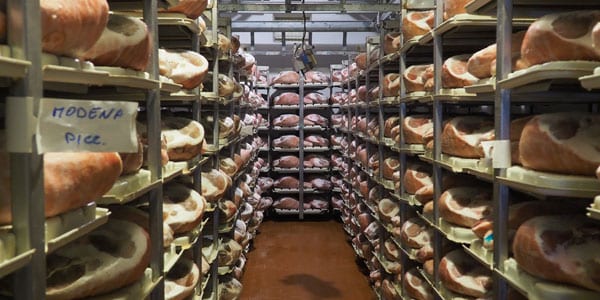
Sparkling wine and Lambrusco are the best to drink with the fatty products found in this area. Especially sausages, to which the first museum in Italy has been dedicated, the MUSA (Museo de la salumeria, www.museodellasalumeria.it). Set up by the Villani sector company, with 130 years of history. It is located in Castelnuovo, a town that has a bronze statue in the shape of a pig in its central square.
In total there are 50 companies dedicated to sausages with 1.200 workers that make this territory one of the most important in the sector at European level.
The terrain of north-central Italy is rich in oak trees, which favors the raising of wild boars and pigs. The pig industry grew as the whey used to make Parmigiano Reggiano cheese was sold to farmers. They mixed it with cereal flour to make the pigs fat. In Modena there are still signs prohibiting entering the city with pigs.
Modena, land of sausages
The museum has in detail the forms of production of the different sausages and their corresponding tools. The amount of salt - "salume" derives from meat preserved with salt - continues to depend on the master's eye, as is also handmade by ligating it with a rope. The most typical of Modena are the cotechino and the zampone, both PGI. Also the coppa di testa (the residual part of the head), the salami, and the prosciutto of Modena.
San Daniele and Parma, the hams of the area
Ham has been produced in this area for 2.000 years and it is said that the legions of Romans came here to supply it as an energy product. Also for wedding parties. Its preparation now is the same as then with the difference that there are currently refrigerators and they are made all year round. Davide Nini, owner of the Nini Gianfranco ham shop (www.prosciuttifionini.it) and president of the Consorzio del prosciutto de Modena, tells us that, “for dietary reasons, now they add less salt. Around 10% less in hams and sausages has reached a reduction of 40% ”. Preservatives cannot be added to Modena, San Daniele and Parma hams, they only contain salt.
Italian hams have less salt than Spanish ones, but they spend more days in salting, which here lasts three weeks: with the first salt they are one week, and with the second, two weeks.
Then they rest for 90 days in a room where winter is recreated. After drying, the ideal curing of these hams is between 18 and 24 months. Just as in the hams in the north of Italy, in addition to salt, they are smoked, and in the south, where it is less cold, pepper is added, which has a preservative action. Modena ham has only salt. The San Daniele and the Parma at first glance differ because the former, thinner, keeps the hoof, and the Parma cuts it off. As can be seen in the Museo de la Salumeria. The San Daniele has a stronger flavor and the Parma, sweeter. Italian hams are not cut lengthwise as in Spain, but widthwise.






